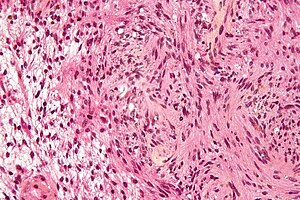Neurofibromatosis 2
| Neurofibromatosis type II | |
|---|---|
| Synonyms | multiple inherited schwannomas, meningiomas, and ependymomas (MISME syndrome) |
 |
|
| Micrograph of a schwannoma, a tumor seen in neurofibromatosis type II. HPS stain. | |
| Classification and external resources | |
| Specialty | medical genetics |
| ICD-10 | D33, Q85.0 (ILDS Q85.020) |
| ICD-9-CM | 237.72 |
| OMIM | 101000 |
| DiseasesDB | 8960 |
| MedlinePlus | 000795 |
| eMedicine | neuro/496 radio/475 |
| MeSH | D016518 |
| GeneReviews | |
Neurofibromatosis type II is a genetic condition which may be inherited or may arise spontaneously. The main manifestation of the condition is the development of symmetric, benign brain tumors in the region of the cranial nerve VIII, which is the "auditory-vestibular nerve" that transmits sensory information from the inner ear to the brain. Many people with this condition also experience visual problems. NF II is caused by mutations of the "Merlin" gene, which seems to influence the form and movement of cells. The principal treatments consist of neurosurgical removal of the tumors and surgical treatment of the eye lesions. Historically the underlying disorder has not had any therapy due to the cell function caused by the genetic mutation. However, new drug research and some clinical trials have shown some promise in having beneficial effects. Collaborative research to find better treatments is ongoing, such as the work of the Synodos NF-2 Consortium of scientists.
NF II is a microdeletion syndrome involving mutations in the NF2 gene located at 22q12.2 of chromosome 22. It is an inheritable disorder with an autosomal dominant mode of transmission. Incidence of the condition is about 1 in 60,000. There is a broad clinical spectrum known, but all patients checked have been found to have some mutation of the same gene on chromosome 22. Through statistics, it is suspected that one-half of cases are inherited, and one-half are the result of new, de novo mutations.
NF II is caused by a defect in the gene that normally gives rise to a product called Merlin or Schwannomin, located on chromosome 22 band q11-13.1. This peptide is thought to have a tumor-suppressive function. In a normal cell, the concentrations of active (dephosphorylated) merlin are controlled by processes such as cell adhesion (which would indicate the need to restrain cell division). It is known that Merlin's deficiency can result in unmediated progression through the cell cycle due to the lack of contact-mediated tumour suppression, sufficient to result in the tumors characteristic of Neurofibromatosis type II. Mutations of NF II is presumed to result in either a failure to synthesize Merlin or the production of a defective peptide that lacks the normal tumor-suppressive effect. The Schwannomin-peptide consists of 595 amino acids. Comparison of Schwannomin with other proteins shows similarities to proteins that connect the cytoskeleton to the cell membrane. Mutations in the Schwannomin-gene are thought to alter the movement and shape of affected cells with loss of contact inhibition. Ependymomas are tumors arising from the ependyma, an epithelium-like tissue of the central nervous system. In patients with NF2 and ependymomas, the tumor suppressant function of Merlin may be compromised. Loss of function mutations occurring in chromosome 22q, where Merlin proteins are coded, can promote tumorigenesis, or the creation of new tumorous cells. Deletions, too, in the NH2-terminal domain of merlin proteins have been associated with early tumor onset and poor prognosis in affected patients.
...
Wikipedia
